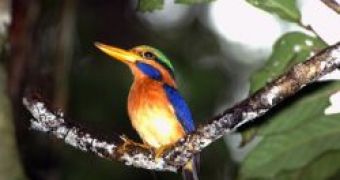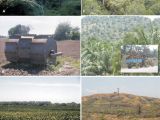All life on our planet is integrated in a highly complex system of interactions and it is difficult to say how a certain perturbation will spread through the global ecosystem. Nonetheless, in spite of this complexity, scientists for the past decades have tried to figure out the interconnections between various life forms and the environmental conditions.
Human beings are, of course, a part of this system of life. We are dependent on many other life forms, a dependence that ranges from the oxygen we breathe to the food we eat (to name the obvious) and have in turn a large impact on other life forms. Even our technology stems from life, considering that oil is a fossil fuel and that, beside its use as an energy source, it is essential for the chemical industry (from plastics to medicine).
But humans have an unusual place in the global ecosystem. This is due to the fact that we have spread to a much larger number of ecosystems and environments than any other living creature (maybe besides bacteria) and that we have an impact on a very large number of other species. But with great power should come great responsibility. The perturbations we are causing are so great that we cannot just relax and assume everything will be fine no matter what we do. And we need to worry whether these perturbations will not eventually backfire on ourselves included.
A new study by Sandra D?az, professor of ecology and biogeography at Instituto Multidisciplinario de Biolog?a Vegetal, Universidad Nacional de C?rdoba, Argentina, and three colleagues from the United States aim at putting together all the data that has been gathered so far about the connection between biodiversity and human well-being. The paper is published in the open-access journal PLoS Biology.
Ecosystem services and what endangers them most
The authors define biodiversity and the "ecosystem services" in the following way:
"Biodiversity in the broad sense is the number, abundance, composition, spatial distribution, and interactions of genotypes, populations, species, functional types and traits, and landscape units in a given system."
"Biodiversity influences ecosystem services, that is, the benefits provided by ecosystems to humans, that contribute to making human life both possible and worth living," the authors write. They cite examples of organisms that are important for human life, examples such as the "pollination and seed dispersal of useful plants, regulation of climatic conditions suitable to humans and the animals and plants they consider important, the control of agricultural pests and diseases, and the regulation of human health. Also, by affecting ecosystem processes such as biomass production by plants, nutrient and water cycling, and soil formation and retention, biodiversity indirectly supports the production of food, fiber, potable water, shelter, and medicines."
The question is how to get beyond just examples and to form a general view of what exactly is important about biodiversity. In order to do that, the authors have reviewed the literature describing such examples and identified the themes that occur most often. What are the main components of diversity and the most important mechanisms than have an impact on the "ecosystem services"?
"All components of biodiversity, from genetic diversity to the spatial arrangement of landscape units, may play a role in the long-term provision of at least some ecosystem services," they write. "However, some of these components are more important than others in influencing specific ecosystem services. The evidence available indicates that it is functional composition - that is, the identity, abundance, and range of species traits - that appears to cause the effects of biodiversity on many ecosystem services."
Thus, what is important is not exactly the diversity of organisms themselves but the diversity of traits. In other words, having a hundred species that resemble each other and do the same things is not very useful. Functional composition has proven to be important for the amount and stability of the biomass produced by plants considered important to humans, to the preservation of the fertility of soils, to the regulation of quantity and quality of available water, to the pollination of many important plants such as fruit trees, to the resistance to invasive organisms and pest and to disease control in agriculture, to the regulation of the climatic conditions through various feed-back mechanisms and to the protection against natural hazards such as floods or forest fires. Its importance is quite extensive!
The importance of functional composition also means that the precise analysis of various ecosystems is more difficult - one cannot use the same approach to all ecosystems, one has to account for their specific conditions. "Precisely because ecosystem processes depend on the presence and abundance of organisms with particular functional traits, there is wide variation in how ecosystem services - that in turn depend on ecosystem processes - respond to changes in species number as particular species are lost from or get established in the system," the authors write. "So, to the question of how biodiversity matters to ecosystem services, we have to reply that it depends on what organisms there are. Daunting? Certainly, but not hopeless."
Winners and losers
The reason why this isn't hopeless is that the processes involved are not random. The loss of biodiversity, as well as its specific consequences, are caused by specific factors and thus can be predicted. One can tell what organisms tend to perish and which to thrive.
"As a consequence of global change drivers, such as climate, biological invasions, and especially land use, not only is the total number of species on the planet decreasing, but there are also losers and winners. On average, the organisms that are losing out have longer lifespans, bigger bodies, poorer dispersal capacities, more specialized resource use, lower reproductive rates, and other traits that make them more susceptible to human activities such as nutrient loading, harvesting, and biomass removal by burning, livestock grazing, ploughing, clear-felling, etc. A small number of species with the opposite characteristics are becoming increasingly dominant around the world."
Forest ecosystems in the tropics and subtropics are being quickly replaced by industrial crops and plantations. This provides large amounts of goods for national and international markets, but results in the loss of crucial ecosystem services mediated by ecological processes. In Argentina and Bolivia, the Chaco thorn forest (A) is being felled at a rate considered among the highest in the world (B), to give way to soybean cultivation (C). In Borneo, the Dypterocarp forest, one of the species-richest in the world (F), is being replaced by oil palm plantations (G). These changes are irreversible for all practical purposes (H). Many animal and plant populations have been dramatically reduced by changing land use patterns, to the point that they could be considered functionally extinct, such as the giant anteater in the Chaco plains (D) and the maned wolf (E), and the orangutan (J) and several species of pitcher plants (I) in the Bornean rainforest. Photos by Sandra D?az, except (A and C), courtesy by Marcelo R. Zak.
Unexpected "natural experiments"
Some unfortunate accidents have also given the scientists the chance of studying the impact the loss of biodiversity has. They had the chance of observing the dramatic unexpected consequences the removal or introduction of certain predator, pathogen, herbivore, or plant species to some ecosystems had had.
"These 'ecological surprises' usually involve disproportionately large, unexpected, irreversible, and negative alterations of ecosystem processes, often with repercussions at the level of ecosystem services, with large environmental, economic, and cultural losses. Examples include the cascading effects of decreases in sea otter population that led to coastal erosion in the North Pacific, and a marked decrease in grassland productivity and nutritional quality in the Aleutian islands as a consequence of decreased nutrient flux from the sea by the introduction of Arctic foxes. The vast literature on biological invasions and their ecological and socio-economic impacts further illustrates this point."
"Ecological surprises are difficult to predict," authors write, "since they usually involve novel interactions among species. They most often result from introductions of predators, herbivores, pathogens and diseases, although cases involving introduced plants are also known."
Such surprises and the difficulty to predict them, because of the complex relationships involved, make it impossible to define a level of biodiversity loss that is safe. Nonetheless one can predict that "the most dramatic changes in ecosystem services are likely to come from altered functional compositions of communities and from the loss, within the same trophic level, of locally abundant species rather than from the loss of already rare species."
Clockwise from top left: The stinging Indo-Pacific nomadic jellyfish (Rhopilema nomadica), first seen off Israel's Mediterranean coast in 1977 and now present along the Levant coast in large numbers during the summer; the raccoon (Procyon lotor), introduced in Europe in the late 1920s for fur farming, has spread to several central and western European countries, having ecological, agricultural, and health-related impacts; the Spanish slug (Arion vulgaris), originating from the Iberian Peninsula, has invaded many areas of Europe; the zebra mussel (Dreissena polymorpha), introduced from Russia via shipping canals to non-native areas in Europe in the 18th and 19th centuries and later to North America, where it has large negative impacts; the yellow sage (Lantana camara), an invasive weed from tropical America with many cultivars and hybrids, was introduced as an ornamental shrub in Europe and many other areas; and the common myna (Acridotheres tristis), a highly invasive bird species, which was recently introduced to several Mediterranean countries and is rapidly expanding its range.Photos: Nomadic jellyfish, Bella Galil; raccoon, non-copyright (http://www.sxc.hu/photo/373074), Spanish slug, Inger Weidema; zebra mussel, Dan Minchin; yellow sage, Salit Kark; common myna, Yotam Orchan, Assaf Shwartz.
Who loses first and the most?
The negative consequences of the biodiversity loss are felt especially by the people who are closest to nature in terms of food security, medicinal products, fuel, construction materials, and protection from natural hazards such as storms and floods. These people are also usually the poorest and the ones having least access to political representation.
"Because of their low economic and political power, the less privileged sectors cannot substitute purchased goods and services for the lost ecosystem benefits and they typically have little influence on national policy. When the quality of water deteriorates as a result of fertilizer and pesticide loading by industrial agriculture, the poor are unable to purchase safe water. When protein and vitamins from local sources, such as hunting and fruit, decrease as a result of habitat loss, the rich can still purchase them, whereas the poor cannot. When the capacity of natural ecosystems to buffer the effects of storms and floods is lost because of coastal development, it is usually the people who cannot flee-for example, subsistence fishermen-who suffer the most."
Due to those reasons the authors argue that economic activities which have destructive effects for the ecosystems tend to hurt the disadvantaged segments of society first and thus to accentuate the inequalities. This leads to the "marginalization of the most vulnerable sectors of society, by decreasing their access to basic materials for a healthy life and by reducing their freedom of choice and action. ... Biodiversity change is therefore inextricably linked to poverty, the largest threat to the future of humanity identified by the United Nations."
The authors conclude that the degradation of the global ecosystem "is threatening the fulfillment of basic needs and aspiration of humanity as a whole, but especially, and most immediately, those of the most disadvantaged segments of society."

 14 DAY TRIAL //
14 DAY TRIAL // 

